AI is a Tool, Not a Threat... Yet. Here's the Reality Check the Wine Industry Needs
📖 Read Time: Approx. 8 minutes
As I was writing this article, I found myself thinking about what angle I could take to make it even more personal and drive the message home. You all know me by now, I love novelty and I'm never scared to explore the unknown.
Then came the idea to prompt and play with AI to see how far it could take my description and create reality from my words. So I described myself to AI, giving it my measurements, my facial structure, mentioning that I wear dreadlocks and love bold colors. I also told it what I do: a Kenyan wine consultant with a passion for rare grapes and creating tailored food and spice blends.
The result was remarkable. An incredibly accurate digital version of me that captured not just my physical appearance but somehow conveyed my personality and cultural identity. If AI can create this level of accuracy from just my written description, what else can it achieve? This experiment became the perfect metaphor for what I'm about to share with you about AI's evolution in our industry.
A Year of Rapid Change
A year and a few months ago, I wrote about how Artificial Intelligence (AI) might impact the wine business. At the time, I believed our jobs were safe, at least for the foreseeable future. I said AI would be a tool, not a replacement. Today, my answer is more complicated: yes and no.
From what I've observed, we're no longer entirely safe. AI has quietly but effectively begun taking over certain tasks within the wine industry—particularly in logistics, administration, and finance. It can process orders, manage inventory, forecast demand, and crunch numbers with speed and precision that frankly puts our manual processes to shame.
I've experienced this transformation first-hand. Every few months, I run comprehensive data analyses comparing wine sales between the East African and European markets. This process typically involves gathering figures from multiple sources, creating Excel sheets, running complex calculations, and meticulously ensuring there are no errors, a process that would consume entire afternoons.
Recently, I decided to experiment. I asked AI to review my dataset and correct any errors. What I received back was not only accurate but significantly improved, streamlined, cleaner, and easier to interpret. The analysis was more thorough than mine, with insights I hadn't considered and visualizations that made the data story crystal clear.
It was impressive, enlightening, and deeply concerning all at once. AI had taken what I built and made it better. And it accomplished this in minutes, not hours.
The Current Reality: AI's Expanding Footprint
While AI hasn't yet mastered the sensory evaluation of wine, our supposed last bastion, it's advancing rapidly in areas that directly support winemaking and wine business decisions. The applications are more extensive than many in our industry realize:
Vineyard Management Revolution AI systems are analysing satellite imagery to assess vineyard health with unprecedented accuracy, predicting optimal harvest timing down to specific vineyard blocks. These systems can detect stress indicators invisible to the human eye, monitoring everything from water stress to disease pressure across thousands of acres simultaneously.
Precision Winemaking Fermentation monitoring has reached levels of precision that would have seemed like science fiction just a few years ago. AI can track temperature fluctuations, sugar conversion rates, and chemical changes in real-time, making micro-adjustments that ensure consistency batch after batch.
Consumer Behaviour Prediction Perhaps most striking is AI's ability to predict consumer preferences with startling accuracy. By analysing purchasing patterns, review sentiment, and even social media behaviour, AI systems can forecast which wines will resonate with specific demographics, sometimes before the wines are even released.
Quality Control and Fraud Detection AI is becoming sophisticated at detecting wine faults through spectral analysis, identifying issues that might escape even experienced tasters during busy harvest periods. It's also being deployed to combat wine fraud, analysing chemical signatures to verify authenticity and provenance.
Blending Optimization Some forward-thinking wineries are using AI to optimize blending ratios based on chemical analysis, creating consistent house styles while maximizing the potential of each vintage's unique characteristics.
What's particularly striking about these developments is how AI is beginning to understand the relationship between chemical compounds and perceived flavours. Recent advances in molecular gastronomy and flavour science suggest that taste and aroma, our supposed safe havens may not remain protected indefinitely.
The Sensory Frontier: Closer Than We Think
For now, what's keeping sommelier expertise and human tasting relevant is that AI cannot yet replicate human sensory perception in its full complexity. It can't taste, smell, or experience wine the way we can. It doesn't understand how a wine's character evolves with temperature changes, how it interacts with different foods, or how the same wine can evoke completely different emotions depending on the setting and company.
But here's what should genuinely concern us: AI doesn't need to replicate human senses exactly to disrupt our expertise. It might develop something entirely different and potentially superior.
Consider the current trajectory: electronic sensors can already detect chemical compounds at levels far below human perception. AI systems are rapidly learning to correlate these molecular signatures with flavour profiles described in thousands of wine reviews and professional tastings. Machine learning models are beginning to predict which wines consumers will enjoy based on their previous preferences and a wine's detailed chemical fingerprint.
The question isn't whether AI will ever "taste" wine like humans do. The question is whether it needs to replicate our biological limitations to be effective.
Imagine an AI system that can instantly analyse a wine's complete chemical profile, cross-reference it against databases of similar wines and their critical reception, factor in current market trends and consumer preferences, and then provide detailed tasting notes and pairing recommendations. It wouldn't taste the wine, it would understand it in ways we never could.
What This Means for Wine Professionals
The wine industry needs to evolve our thinking beyond simply protecting existing roles. We're at a crossroads, and the decisions we make now will determine whether we shape AI's integration into our industry or find ourselves displaced by it.
Embracing Enhancement Over Replacement
The smartest approach is asking how we leverage AI to enhance rather than replace human expertise. AI might help sommeliers access deeper technical knowledge instantly, providing real-time information about a wine's provenance, optimal serving conditions, or perfect food pairings based on molecular compatibility.
For winemakers, AI could serve as an invaluable consultant, offering insights into fermentation optimization, blend ratios, and quality control that complement rather than replace human intuition and artistry.
Doubling Down on Human Value
While AI may eventually analyse flavour profiles with mathematical precision, humans excel at areas that remain difficult to quantify: storytelling, cultural context, emotional connection, and creating memorable experiences around wine.
As a Kenyan wine consultant, I bring perspectives shaped by my Luhya culture, my understanding of African palates, and my experience bridging traditional and modern approaches to wine. These cultural nuances and personal experiences are irreplaceable—at least for now.
Preparing for Sensory AI
Rather than hoping AI will never develop sophisticated sensory analysis, we should be developing new skills and redefining our professional value. This might mean becoming AI collaborators, learning to interpret and contextualize AI-generated insights, or specializing in areas where human judgment remains paramount.
Cultural Heritage Meets Technological Future
My experiment with AI creating my digital avatar highlighted something profound about our industry's future. AI captured my physical appearance and even hinted at my cultural identity, but it couldn't replicate the lived experience that shapes how I approach wine.
My Kenyan perspective brings unique value to wine consultation. Understanding how traditional African flavours interact with international varietals, recognizing the potential for indigenous ingredients in food pairings, and appreciating the cultural significance of sharing wine in different social contexts.
This cultural depth, combined with personal experience and emotional intelligence, represents the kind of human value that will remain relevant even as AI capabilities expand. The key is recognizing this value and learning to articulate it clearly.
The Path Forward: Integration, Not Resistance
The wine world needs to start thinking strategically about AI integration, now. We have a brief but critical window to shape how AI enters our industry rather than being disrupted by it.
Smart wine professionals are already beginning to learn AI systems, understanding their capabilities and limitations. Progressive wineries are exploring how AI can improve their precision and efficiency while preserving the artistry and tradition that define great winemaking.
Most importantly, we need to recognize that our industry's ultimate value lies not just in our technical ability to analyse wine, but in our capacity to create meaning, culture, and human connection around it.
The wine industry has always been about storytelling. The story of the land, the vintage, the winemaker's vision, and the moment when wine brings people together. AI might help us tell these stories more effectively, but it cannot create the stories themselves.
A Personal Call to Action
The question isn't whether AI will eventually challenge every aspect of wine expertise, it probably will. The question is whether we'll be ready to evolve alongside it.
My AI avatar experiment taught me something important: AI is remarkably good at synthesis and replication, but the original inspiration—the cultural background, personal experiences, and creative vision, that had to come from me.
In wine, we are the original inspiration. AI might help us analyse, optimize, and even predict, but the passion, creativity, and human connection that drive our industry cannot be replicated.
The choice is ours: wait to see what AI will do to us, or decide what we'll do with AI.
Wine has always required adaptation, to climate variations, changing consumer preferences, new regulations, and market disruptions. AI is simply our latest evolution challenge, and like those before it, it's one we can meet successfully if we approach it strategically.
Rather than fearing AI, let's learn to dance with it. Let's use its capabilities to amplify our human strengths while doubling down on what makes our contributions irreplaceable.
What are your thoughts? How is your corner of the wine world preparing for this technological evolution? And more importantly, what uniquely human value will you choose to cultivate as AI capabilities continue to expand?
The future of wine isn't about humans versus AI, it's about humans with AI, creating something more remarkable than either could achieve alone.



